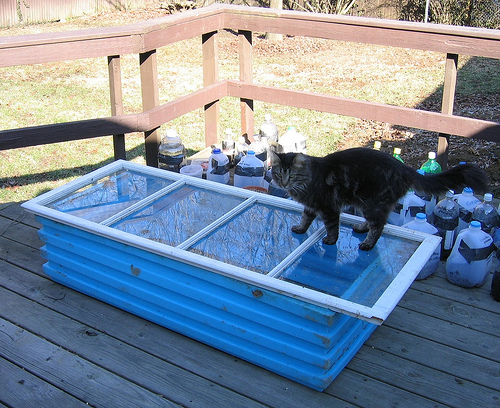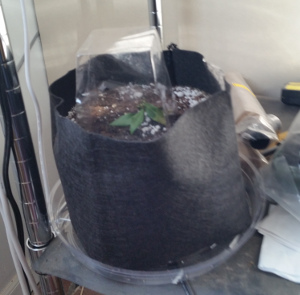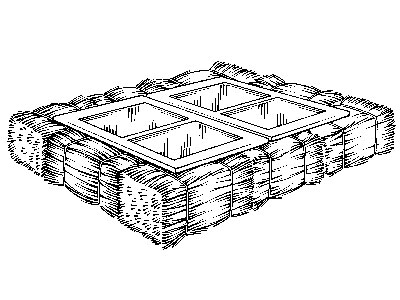It’s the first week of the New Year, and temperatures have dropped to the negative in Indiana. Even wearing layers of shirts and pants we had to turn on the space heater in the living room to keep the coldest parts of the night at bay. There is absolutely no doubt about it; it’s winter. Just because it’s winter doesn’t mean that you can’t keep a garden going or start seeds a little later in the season. Don’t get discouraged if you’ve heard of cold frames and only have a patio. There are even solutions for you, if you’re willing to get a little creative.
And remember, it’s not insane to want fresh food all year round.
Let’s start at the top with the classic cold frame. These frames are often built as a box with a sloping, clear frame that either sits on the ground or build as a raised bed. These are not the only options for building a cold frame! Organic Gardening did a great piece on how to build a cold frame that shows you that you don’t have to have a dedicated store bought box. You can literally surround an area with straw for protection, then add a couple old window frames with sturdy glass to the top.
The key for cold frames is insulation from the temperatures, a way to let sunlight in, and to keep the weight of the snow off the glass so it doesn’t shatter. This literally means you can use an old tire for insulation (and it helps that the black tire keeps the air temp warm) and a circular piece of plexiglass on top. It’s small enough to fit on a patio so you can grow cold-tolerate plants even on the coldest days.
 Another option is to follow in the footsteps of Kasmira, the “ghetto princess”, and build a cold frame using an industrial box and an old window. If you can’t bury it into the ground for insulation, your next best bet is to surround it with straw on either the inside or the outside of the box when you need an extra hit of insulation during the cold weeks and nights of the winter. Frankly, I think this is genius set up is genius. It’s small enough to fit on most balconies, large enough to grow a good crop of various cold-hardy vegetables.
Another option is to follow in the footsteps of Kasmira, the “ghetto princess”, and build a cold frame using an industrial box and an old window. If you can’t bury it into the ground for insulation, your next best bet is to surround it with straw on either the inside or the outside of the box when you need an extra hit of insulation during the cold weeks and nights of the winter. Frankly, I think this is genius set up is genius. It’s small enough to fit on most balconies, large enough to grow a good crop of various cold-hardy vegetables.
Another way to make this set-up a little more insulated is by using the exact idea Kasmira showed in the background. Put the small plants and seedlings into the milk jugs, tape the top back on, remove the caps, and then put them into the cold frame. Insulate them with more soil or straw, and you’ve got yourself a very well insulated cold frame to start seedlings in or grow small crops like lettuces.
If you are lucky enough to live in a place where you can plant in the ground, and you have a sheltered area, you can take the milk jug idea a step further by using them as cloches for the plants. Simply cut the bottom off instead of in the middle, then place it over the top of a plant to keep it protected during cooler weather. A cloche may not keep the plants protected during the bitter cold nights, but it will get you through most of the winter. And if you’re not a milk drinker? Take a lesson from Marie James at Grit: use other containers as long as they are transparent, solid, and sturdy. This includes peanut butter containers, totes, or just about anything else you can find laying around. If they don’t give the plant a little room to breathe, remove the cloche for a few minutes every day (during the warmest part of the day, if possible) to exchange the oxygen levels in the trapped container so the plant doesn’t suffocate.
 And, for those of us that are dealing with the issue of a tiny balcony, there is an ingenious solution that will take up very little room, use your existing pots, AND provide you with delicious vegetables. I learnt this trick from Urban Farmer Seed Company when I visited:
And, for those of us that are dealing with the issue of a tiny balcony, there is an ingenious solution that will take up very little room, use your existing pots, AND provide you with delicious vegetables. I learnt this trick from Urban Farmer Seed Company when I visited:
Take a pot, and fill it with soil. Then, plant the seeds or seedling. Take another, transparent pot that will fit inside of the other one, and give it a hat. Take off the top every day to let the plant breathe and water it frequently, and you should have a great winter container garden.
The felt container they have this in is great for indoor work, but not the best for outside gardening — especially if it freezes. Instead, look for pots that are suitable to your climate. After that, let nothing stop you from having an amazing garden all year round.


